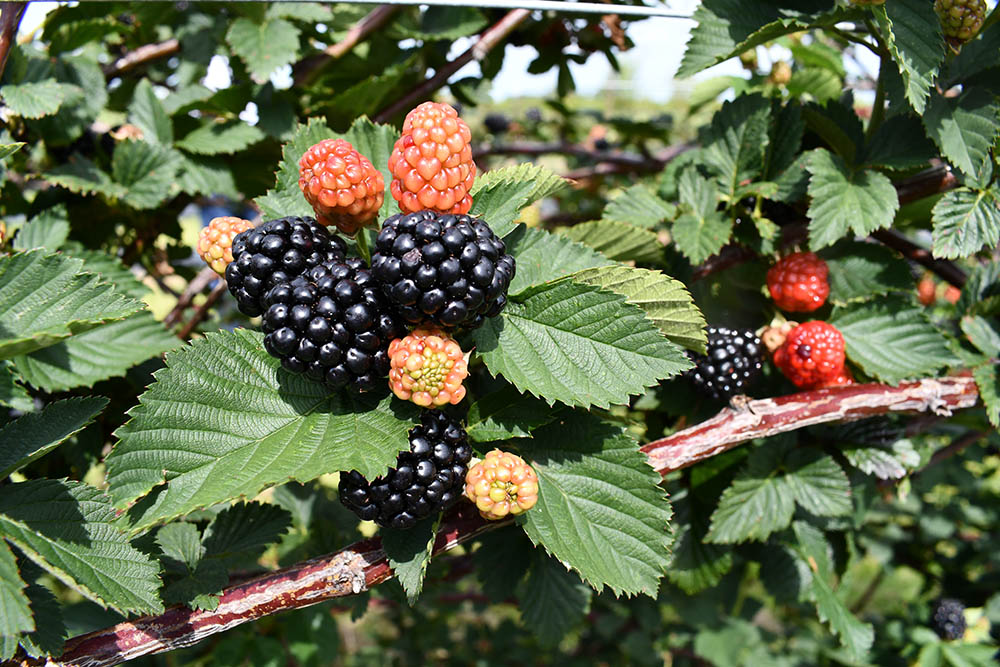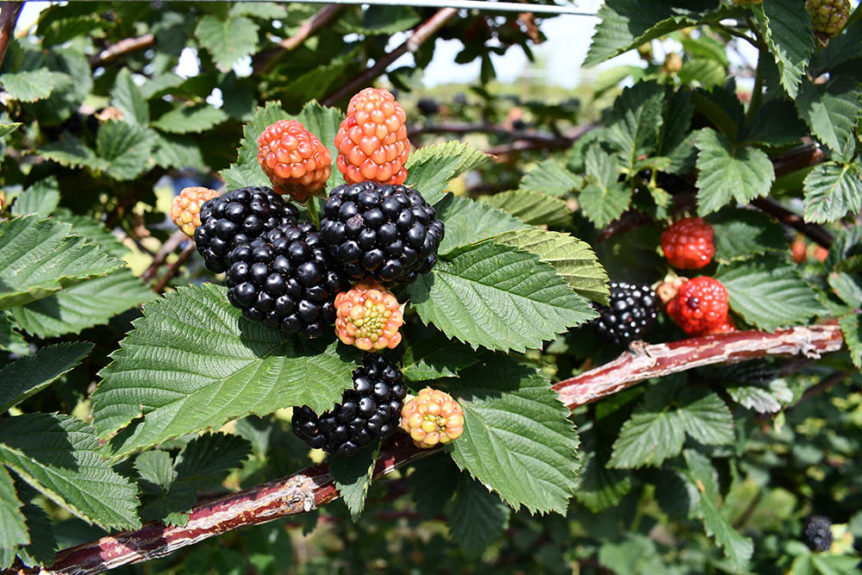
Florida specialty crop farmer Matt Parke may still be a relative newbie when it comes to blackberry production. But he seems to have figured out a secret to blackberry success in Central Florida.
“Here in Central Florida, we don’t get the chill hours required to make them flower good, so you’ve got to figure out how to trick them into thinking they’ve got enough cold to produce. We shut them off in October, got them to defoliate by January, and the buds started swelling,” said Parke, farm manager of Parkesdale Farms in Plant City, Florida. “The way it’s running right now I could probably get almost 10,000 pounds to the acre, which is about 3,000 or 4,000 more than normal.”
This is Parke’s second season growing blackberries and he’s excited about a growth spurt in production compared to last year.
“We’re picking pretty good. Last year, they didn’t pick as well. I was trying to learn them. This year I’ve got them figured out and picking a good crop off,” Parke said.
Parke, a large strawberry producer, wanted to diversify his crop portfolio. That is why he ventured into blackberry production but only in small increments.
“We didn’t plant too many acres of them. We’ve got eight acres which is not a drop in the bucket,” Parke said. “I could have planted more but I wanted it to prove itself before I made a bigger investment.”
Downy Mildew Disease Observed in Florida, Georgia Watermelons
Downy mildew disease was observed in North Florida and South Georgia watermelons in mid-May. Bob Hochmuth, University of Florida Institute of Food and Agricultural Sciences regional specialized Extension agent in Live Oak, Florida, confirmed the presence of the disease in the southern part of the Suwannee Valley.
He also confirmed that Ty Torrance, University of Georgia Cooperative Extension vegetable agent for Colquitt, Tift and Worth counties, reported downy mildew in a watermelon field in Tift County.
Hochmuth emphasized that the downy mildew infection in both Florida and Georgia is very aggressive.
“It is unusual to have the situation where downy is found as far apart as southern Suwannee Valley all the way to Tift County,” he noted. “Therefore, it is likely the entire Suwannee Valley is at risk. Downy mildew was first confirmed in 2023 on May 3.
Excellent Sweet Corn Crop for Florida
The week prior to Memorial Day weekend is usually prime time for Florida’s sweet corn producers. This year was not any different, according to Tori Rumenik, director of commodity services and supply chain at the Florida Fruit & Vegetable Association.
“We’ve got excellent supply in Florida for the holiday. I think you can look to Florida for good volumes and also really good quality. When I’m talking to handlers and growers, some of them are saying this is some of the best quality they’ve seen in a long time. That’s exciting,” Rumenik said.
“We really look to Memorial Day as the end of our season but also the big push for our season. That’s especially true when we get some really good warm weather down in South Florida. The corn comes off, and it’s pretty and ready to go for the holiday.”
Rumenik said Florida growers would harvest the crop up until the holiday before harvests shifted into Georgia.
Challenging Weather Impacting Alabama Watermelon Producers
Alabama’s watermelon crop was on pace for a normal, average year, according to one producer. Jeremy Sessions, who farms 50 acres in Grand Bay, Alabama, said in May that he should have been ready to harvest by June 10. This comes despite challenging weather conditions throughout the growing season.
“Everything looks pretty good. Early, we had some tough growing conditions. They were kind of cool with a lot of wind and it beat the plants up a little bit. This warm weather has got things growing pretty nice,” Sessions said.
Another challenge was how to navigate the excessive rainfall being felt across the Southeast. It can lead to increased disease instances, especially if growers are unable to access the fields to apply fungicides.
“There’s a whole array of diseases that can be triggered by all of that rainfall. We try to keep them sprayed and stay on a good schedule, but there’s only so much that you can combat it with,” Sessions said. “You just don’t grow as good of a watermelon whenever it rains. The watermelons won’t be as sweet, de pending on when it rains. You can grow a better crop in a hot, dry year if you’ve got irrigation. It can affect the quality. It can affect the sweetness.”
Sessions started planting this year’s crop at the end of March and staggered plantings so the crop could extend through July 4.
Bacterial Spot Increasing in Peach Crop
Increased rainfall in late May made the peach crop across the Southeast susceptible to disease buildup.
According to Phil Brannen, University of Georgia Cooperative Extension fruit disease specialist, bacterial spot was of most concern.
“Generally, the crop is excellent. We’ve got a big crop. Hopefully, we can carry a high percentage of that crop,” Brannen said. “The only negative that I am aware of is bacterial spot starting to show up on some of the more susceptible varieties and even on some of the moderately, susceptible varieties that makes sense based on the rainfall pattern that we’ve had.
“The growers are just going to have to make sure they’re using a lot more copper and also the antibiotics that are going to control that disease, especially if the rain continues. Hopefully, it’ll dry off a little bit as we get into the other varieties where we won’t have that problem.”
Bacterial spot is a sporadic leaf-spot disease that can cause defoliation in certain cultivars. Spots can also appear on the fruit, causing damage and leaving fruit unmarketable.
“It needs rain to infect, and when you have moist conditions, especially long-standing moisture where it doesn’t dry off the fruit itself, you’ll get infection. The primary time for infection is right after bloom,” Brannen said. “About three to four weeks after bloom is where we think we get most of our infection, but when it’s raining as much as it is now, we can get later infections, and that’s what we’re seeing some of now.”










